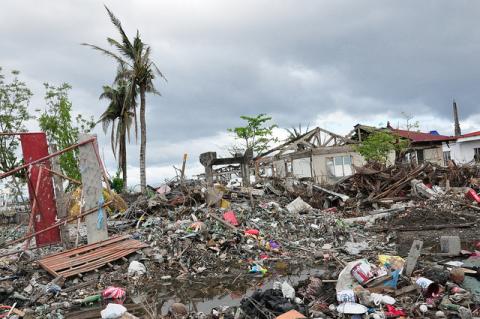
The following article, written by Maryknoll Sr. Marvie Misolas, was published in the July-August 2014 NewsNotes. See Sr. Misolas' article, "Philippines: Climate crisis," in the January-February 2014 NewsNotes.
Disaster Risk Reduction and Management (DRRM) is a familiar phrase nowadays all over the Philippines. Filipinos regularly experience multiple natural and human caused calamities ranging from earthquakes, tidal waves, volcanic eruptions, flash floods and landslides, super typhoons and fires and drought. The negative effects of climate change add to the increased and extreme occurrence of weather related disasters in the Philippines because of its location and being archipelagic (groups of islands). Named typhoon of the century, Haiyan (local name: Yolanda) made landfall in November 2013 in the central Philippines, leaving more than 2,000 people dead and unaccounted, over two million people homeless, with damages costing several billions of pesos. (Photo from the International Labor Organization shows damage in Tacloban.) The realization of the lack of preparedness to extreme disasters necessitated the nation to reflect and pause of lessons learned. It cannot be business as usual.
Republic Act of the Philippines No. 9729, known as the Climate Change Act, mandated the establishment of Climate Change Commission (CCC) as the policy-making body of the national government "to coordinate, monitor and evaluate the programs and action plans of the government relating to climate change." The CCC, with the Local Government Units (LGUs), issued the National Climate Change Action Plan of 2010, strategizing actions for adaptation and mitigation from 2011 to 2028. The plan’s seven priorities are: 1) food security; 2) water sufficiency; 3) ecological and environmental stability; 4) human security; 5) climate-friendly industries and services; 6) sustainable energy; and 7) knowledge and capacity development.
It is under human security (#4) and knowledge and capacity development (#7) that all government units are mandated to conduct risk and hazards preparedness assessment and capacity building to Filipino people. It is now being implemented in both private and government agencies through workshops and trainings on disaster risk preparedness and disaster management. One of the models being used for training is the community-based risk reduction management (CDBRRM) model. The principle of CBDRRM aims to harness the strength of local communities being the locus of experience of such disasters. It taps to the resilience of the people. In one of the training session, the participants prepare their geographical community map and identify areas of vulnerability to different kinds of hazards. Disaster management equips leaders to respond to a disaster event methodically and orderly, reducing chaos and conflict.
Beginning May of this year, I have been a part of the Simbahang Lingkod ng Bayan’s CBDRRM program in Payatas, Quezon City, an urban poor area. Many of the residents lived off and work in the garbage dumpsite. This disaster preparedness training program is for a period of one year, exclusively to local executives and their staff in Payatas. Payatas is home to the largest garbage dumpsite in Metro Manila, also popularly known as "Smokey Mountain." In 2000, super typhoon Milenyo (local name), caused a devastating trash-slide, burying more than 200 people who lived near the dumpsite. Aside from trash-slide, Payatas is also under the constant threat of a methane gas explosion, from one of the closed sections of the dumpsite turned into a methane gas plant managed by a private company. Payatas is also adjacent to the Marikina East Fault Line; a 7.2-magnitude earthquake is projected by national and international geoscientists to happen anytime. An earthquake of this magnitude will affect Payatas. Because of these threats, Payatas is considered high risk and one of the most vulnerable communities in greater Manila area.
One of the area leaders, Beth (not her real name), lived next to the creek in Payatas. During the typhoon Ondoy (international name: Ketsana) in 2011, a flash flood happened at mid-morning without warning, although there had been non-stop heavy rain at that time and the creek was starting to overflow. They were lucky to get to a safe place with only the clothes on their backs. Her house and the pigs in her pigpen were washed away. Having no other place to rebuild, her family went back and built another sub-standard housing next to the creek. When asked why she joined the CBDRRM training, Beth responded that she wants to know what to do, and help her family and her neighbors by sharing what she learned with them, if and when another disaster happens again. She also hopes that there will be a safer area where her family could relocate. According to Quezon City ordinance, areas around watershed, creek and spring are natural waterways and may not be used as dwelling zones because of flood vulnerability and the effects of human encroachment such as pollution to these natural ecosystems.
Last June 9 was the CDBRRM Simulation Drill – all areas in Payatas and their local executives who were trained put in action what they have learned. I was assigned to observe Simbahang Lingkod ng Bayan (SLB) as participating NGO, in order to give a report to the drill master and provide feedback of the whole process.
Capacity building in the grassroots level in densely populated and urban poor areas in Metro Manila may well be the most viable approach to reinforce people’s resilience and adapt to impacts of climate change.
